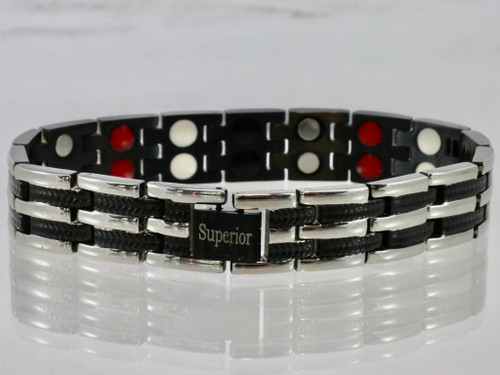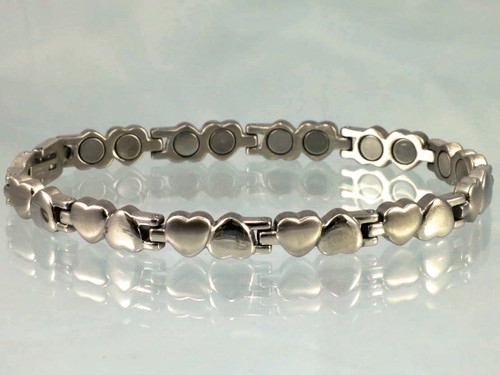Magnetic Bracelet
MAGNETIC BRACELET
Magnetic bracelets are worn by many people. Some of us wear them for the simple health benefits and others wear them for pain relief.
"I have 6 screws and a plate in my right hand. It would just ache. I now wear the Long Island style with the double magnets. It took out all the pain. Last year my mom got a necklace and my dad got a bracelet for his gout." Garret T from Smithfield, UT
MAGNETIC THERAPY BRACELETS
Normally a magnetic bracelet is selected to deal with issues in the hands, elbows, shoulders, back…it can reach the knees on some people. Some of us may get results for issues in the neck. Since we’re not “all the same”, it’s wisest to select the location of wear for the magnetic jewelry based upon the issue you are attempting to relieve.
MAGNETIC BRACELET STRENGTH AND RESULTS
All Magnetic Bracelets (no matter where you purchase them) come with a designated “strength” for the magnet. There is no “rule” as to what strength magnet is put in a piece of jewelry. You need to be educated on this issue because it can dramatically impact your results. Neodymium has an "N" grade classification that designates gauss/strength. N52 is the highest grade and makes the strongest magnetic jewelry.
Know what you’re getting and go stronger if you don’t see results within 4-6 weeks.
Rare earth magnets are used in premium stainless, tungsten, or titanium magnetic bracelets. There are two types of rare earth magnets: neodymium and samarium-cobalt.
Neodymium is preferred for jewelry because it is:
- Strongest magnet at N52 grade (Our Signature Line uses all N52 grade neodymium)
- Even very thin...it's exceptional in it's strength which facilitates it’s use in jewelry
- Can isolate “NORTH” pole of the magnet…premium way to wear magnets
- Retains strength (loses 2% over 100 years)
- Brittle, can chip or shatter (protected by being recessed, capped and coated in the back of each link)
Note: Neodymium looses strength at 590 degrees…so don’t put your magnetic bracelet in the oven!
Samarium-cobalt is used in industrial applications where excessive heat and rusting are an issue…it cannot be made as strong as neodymium’s higher grades.
FACTORS THAT AFFECT PERFORMANCE/RESULTS:
- Grade of Neodymium (N30 weakest, up to N52 strongest manufactured)
- Gauss Strength (a measurement that fluctuates based upon the point at which it is measured…mass of magnetic material can affect this…therefore be aware of size and number of magnets along with N grade
- Location of wear…best worn as close to the problem as possible. We're all a little different, so experiment. Alternate wrists, ankles as needed.
DO NOT WEAR MAGNETS IF...
It is not recommended that people with pacemakers, defibrillators, insulin pumps or other electrical devices (used to monitor critical life support functions) wear magnetic jewelry. The magnet could affect the setting(s) on the device.
There are technologies for these people; our Sport Bracelet is one. Frequency bracelets are another. We will be expanding our selection in the future, so please check-back.
TYPES OF MAGNETIC BRACELETS offered by SuperiorMagnetics:
STAINLESS MAGNETIC BRACELET:
- Will isolate the NORTH pole of the magnetic field…a premium way to wear magnets.
- Can be the strongest magnet available...if it's the N52 grade.
- Most have a single magnet in every link; some have double magnets in each link.
- Can get wet. Not necessary to remove before showering.
- SuperiorMagnetics entire Signature Line has N52 grade neodymium "NORTH" pole magnets...the strongest magnet.
- Made with 316L grade stainless steel.
- Easily sized to fit any wrist. Measure wrist snugly and add 1/2-3/4” (See SIZING).
TUNGSTEN MAGNETIC BRACELET:
- A premium metal; it is preferred for it’s resistance to scratching and has a deep, rich, gloss look.
- Manufactured for SuperiorMagnetics with the N52 grade neodymium magnet.
- Can get wet. Not necessary to remove before showering.
- Easily sized to fit any wrist. Measure wrist snugly and add 1/2-3/4" (see SIZING)
- Has Schumann Frequency embedded at no additional charge.
HEMATITE MAGNETIC BRACELETS:
- Offers a "beadwork" aesthetic...beautiful and personal.
- Custom made to your order using TRIPLE STRENGTH 6mm magnetic Hematite beads. Measure wrist snugly, add 3/4-1 1/4”.
- Natural Stone can be mixed with the triple strength magnetic hematite beads. (Gemstone Therapy)
- Should not get wet. Remove before showering. Clasp can rust in humid environments.
- Call to order if you wish a special combination not listed on the website.
COPPER MAGNETIC BRACELET :
- Considered the "oldest ionizing bracelet" in the world. Worn for centuries for relief.
- Comes in a solid copper cuff design with 2-6 neodymium magnets (2,000 gauss each).
- Also available handmade in a mixture of copper, german silver and jeweler's brass with 2/N50 grade neodymium.
- Can darken the skin under the bracelet (washes off).
- Bangle style (open at back to facilitate on/off).
- Measure wrist snugly and order appropriate size in drop down box (see SIZING).
SPORTS BRACELET :
- A newer addition to this arena of therapy. Athletes and most of our professional baseball players wear this technology.
- X100 strength (strongest available) carbonized titanium in silicone cord, covered by a nylon cover with Aqua Titanium.
- 4 bracelet sizes (also comes in a necklace that has a magnetic closure).
- Can get wet.
- Schumann Frequency 7.83 hz embedded at no additional charge.
- The non-magnetic clasp version can be used by people with pacemakers, defibrillators, or insulin pumps.
SuperiorMagnetic’s magnetic bracelets offer cutting-edge design and maximum gauss rating for deep magnetic penetration. Built to last and give results. Get yours today.
Reference:
K J Magnetics
Wikipedia












